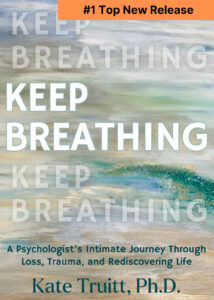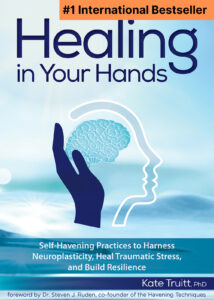Related Resources
For Your Healing Journey
What Is Post-Traumatic Growth?
If there’s post-traumatic stress, there’s also post-traumatic resilience. It involves becoming stronger and wiser after trauma. Just like the phoenix, where one may burn up in the flames and rise again, individuals have the ability to create a space where they learn and grow from what has occurred. In this psychoeducation video, Dr. Kate Truitt discusses how neuroplasticity allows for the creation of post-traumatic resilience at a neurobiological level. When individuals lean into difficult emotions with curiosity for growth, cultivate self-compassion and deeper connections, and use tools like creating possibilities protocols and breathing exercises such as breath titration, it leads to personal empowerment and resilience.
How To Practice Mindful, Healing Touch
In this psychoeducational video, Dr. Kate Truitt will teach us the power of mindful touch for those struggling with touch-related trauma. We explore practical strategies for integrating the self-havening touch into daily life, starting with simple exercises like palm havening and using silly putty and moving on to the havening hug with a warm blanket.
Guided Practice: Creating Possibilities Protocol for Empowering Resilience
Join Dr. Kate Truitt in this transformative guided practice, based on her “Healing in Your Hands” approach. Discover the Creating Possibilities Protocol, a powerful technique that harnesses neuroplasticity and partners with your amygdala to strengthen your preferred emotional states. In this guided practice, Dr. Kate Truitt introduces you to the Creating Possibilities Protocol, a remarkable method for building new neural pathways and enhancing your emotional well-being. Dr. Kate reminds us that our amygdala, Amy, works tirelessly to keep us safe and can also help us cultivate positive feelings.
A Guided Breathing Exercise to Create Space From Anxiety
In this video, Dr. Kate Truitt guides us through a breathing titration exercise to help the body and mind hold space for numerous physical, emotional, and sensory experiences at one time. We can feel multiple states at one time, and performing this titration exercise allows us to listen to what our mind and body are struggling with, while at the same time reminding ourselves that we can feel multiple states at one time.
The Phoenix Journey: Embracing Post-Traumatic Growth
By Dr. Kate Truitt
Have you heard of post-traumatic growth? It might sound like a strange term at first. Post-traumatic implies something traumatic happened, and growth suggests improvement. But don’t worry, it doesn’t mean our trauma symptoms are growing. Instead, it means we are becoming stronger, wiser, and more powerful because of what happened. I like to call this the Phoenix process. Just as the mythical Phoenix burns up in flames and rises again from its ashes, we too can rise from our difficulties stronger, wiser, and more resilient.
What is Post-Traumatic Growth?

Post-traumatic growth refers to the positive psychological changes experienced as a result of struggling with highly challenging life circumstances. It’s not about diminishing the impact of trauma but about finding a path to a stronger, more resilient self. It’s important to differentiate between the idea that our trauma symptoms are growing versus our personal growth following trauma. The Phoenix process embodies this growth – yes, we may burn up in the flames of our challenges, but we will rise again, renewed and empowered.
The Neurobiology of Post-Traumatic Growth
Our brains are incredibly adaptable due to a phenomenon known as neuroplasticity. Neuroplasticity is the brain’s ability to reorganize itself by forming new neural connections throughout life. This means that, even after significant trauma, our brains can adapt and change, supporting growth and recovery.
This dynamic ability allows the brain to recover from injuries, adapt to new situations, and acquire new skills. When we experience trauma, neuroplasticity enables us to rewire our brain’s pathways, creating new ways of thinking and behaving that support healing and growth. Research has shown that consistent engagement in certain activities can strengthen and even create new synapses, the connections between neurons.
If there’s post-traumatic stress, there’s also post-traumatic resilience. In this psychoeducational video, you can learn more on how neuroplasticity makes post-traumatic resilience at a neurobiological level possible.
Supporting Neuroplasticity through Mindful Touch

The Healing Power of Gentle Touch
One powerful approach to fostering growth and healing is through mindful touch, also referred to as the self-havening® touch, a natural mechanism innate to your body’s natural capacity to self-soothe and restore balance. Mindful self-healing touch involves gentle, intentional physical contact with areas such as the arms, face, and palms or soft butterfly taps on the chest, creating a calming environment that helps the body feel grounded and secure—key elements in the journey of emotional recovery.
This process taps into the body’s innate ability to engage the parasympathetic nervous system, which is responsible for states of rest, relaxation, and repair. Through mindful touch, the nervous system is activated in a way that slows heart rate, lowers blood pressure, and releases tension, counteracting the physiological responses associated with stress and trauma. This shift into relaxation allows the body’s built-in healing mechanisms to reduce distress and support emotional regulation naturally. With each experience of mindful touch, the body is gently encouraged to rewrite its responses, reinforcing its natural resilience. This self-healing process highlights the body’s remarkable capacity to transform difficult experiences into opportunities for emotional growth and restored well-being.
Leaning into Difficulty with Curiosity, Self-Compassion and Inner Wisdom
Our brains can hold and experience a multitude of emotions and thoughts simultaneously. By leaning into difficulties with curiosity, we can begin to unravel opportunities for growth, strength, and inner wisdom. This reflection helps us build a foundation of understanding and learning from past experiences, which is crucial for personal development.
Creating a space for self-compassion and tenderness is essential in the healing journey. When we approach ourselves with grace and loving kindness, we cultivate a new way of being that might not have been possible before. This self-compassion allows us to connect more deeply with the world around us. Loss, whether of someone or something, is a unique part of life’s journey. By embracing curiosity about what used to be and moving lovingly into what can be, we help our brains build new ways to experience and process loss and pain.
How Past Experiences Shape Our Current Reality
A significant portion of how our brains experience the world, about 90%, is based on past experiences. This highlights the importance of intentionally curating the brain we want to live with. By being mindful and intentional about our thoughts and experiences, we can shape our brain’s future responses to the world around us. This intentional curation is necessary for creating a resilient and adaptive mindset.
Click here to download your free Neuroplasticity Toolkit for Empowered Healing!
Tools for Post-Traumatic Growth

The Creating Possibilities Protocol
One of my favorite tools for fostering post-traumatic growth is the Creating Possibilities Protocol. This gentle and loving approach encourages us to explore the world through a new lens, helping us to cultivate the experiences and feelings we desire, especially during challenging times. Discover more of the power of the Creating Possibilities Protocol through this guided practice.
Breath Titration Exercises
Another valuable tool for post-traumatic growth is breath titration exercises. These exercises help cultivate awareness of our brain and body’s capacity to hold multiple emotional states at once.
Breath titration is a controlled breathing technique that involves consciously regulating the pace and depth of your breaths. This practice can help you develop greater awareness of your physiological and emotional states, enabling you to navigate complex emotions more effectively. By practicing breath titration, we can enhance our ability to hold and process complex emotional states. It helps us build resilience and emotional regulation, which are essential components of post-traumatic growth.
If you want to learn more about the breathing titration exercise, I invite you to watch this Guided Breathing Exercise to Create Space from Anxiety.
Bringing It All Together
Post-traumatic growth is a powerful and transformative journey that allows us to rise from our challenges stronger, wiser, and more resilient, much like the mythical Phoenix. Understanding and embracing this process can profoundly impact our lives, enabling us to turn adversity into a source of empowerment. Our brains’ remarkable capacity for neuroplasticity provides a scientific foundation for this growth. By leveraging the brain’s ability to reorganize and form new neural connections, we can support our healing and recovery.
Additional Mental Health Resources
If you are looking for deeper insights into the journey of healing, resilience and post-traumatic growth, I invite you to read my book, Keep Breathing: A Psychologist’s Intimate Journey Through Loss, Trauma, and Rediscovering Life. It’s part memoir and part scientific exploration, using my story as a case study of the common experiences in our brain—deep love and devastating loss, exhilaration and pain, life and death—that have the power to derail our lives and inspire us to rebuild, heal, and grow. You can download the first chapter for free by subscribing to my newsletter.

Additionally, in my first book, Healing in Your Hands: Self-Havening Practices to Harness Neuroplasticity, Heal Traumatic Stress, and Build Resilience, you will find powerful client stories, insights from the field of neuroscience, and tools to create a complete and holistic self-healing program that you can use.

References
Truitt, K. (2024). Keep breathing: A psychologist’s intimate journey of healing and rediscovering life after loss. Bridge City Books.
Truitt, K. (2022). Healing in your hands: self-havening practices to harness neuroplasticity, heal traumatic stress, and build resilience. PESI Publishing, Inc.
Boulder Crest Foundation. (n.d.). What is posttraumatic growth (PTG)? Retrieved from https://bouldercrest.org/research-resources/what-is-posttraumatic-growth-ptg/
Psychology Today. (n.d.). Post-traumatic growth. Retrieved from https://www.psychologytoday.com/intl/basics/post-traumatic-growth
Weir, K. (2016, November). Growth after trauma. Monitor on Psychology, 47(10). Retrieved from https://www.apa.org/monitor/2016/11/growth-trauma










